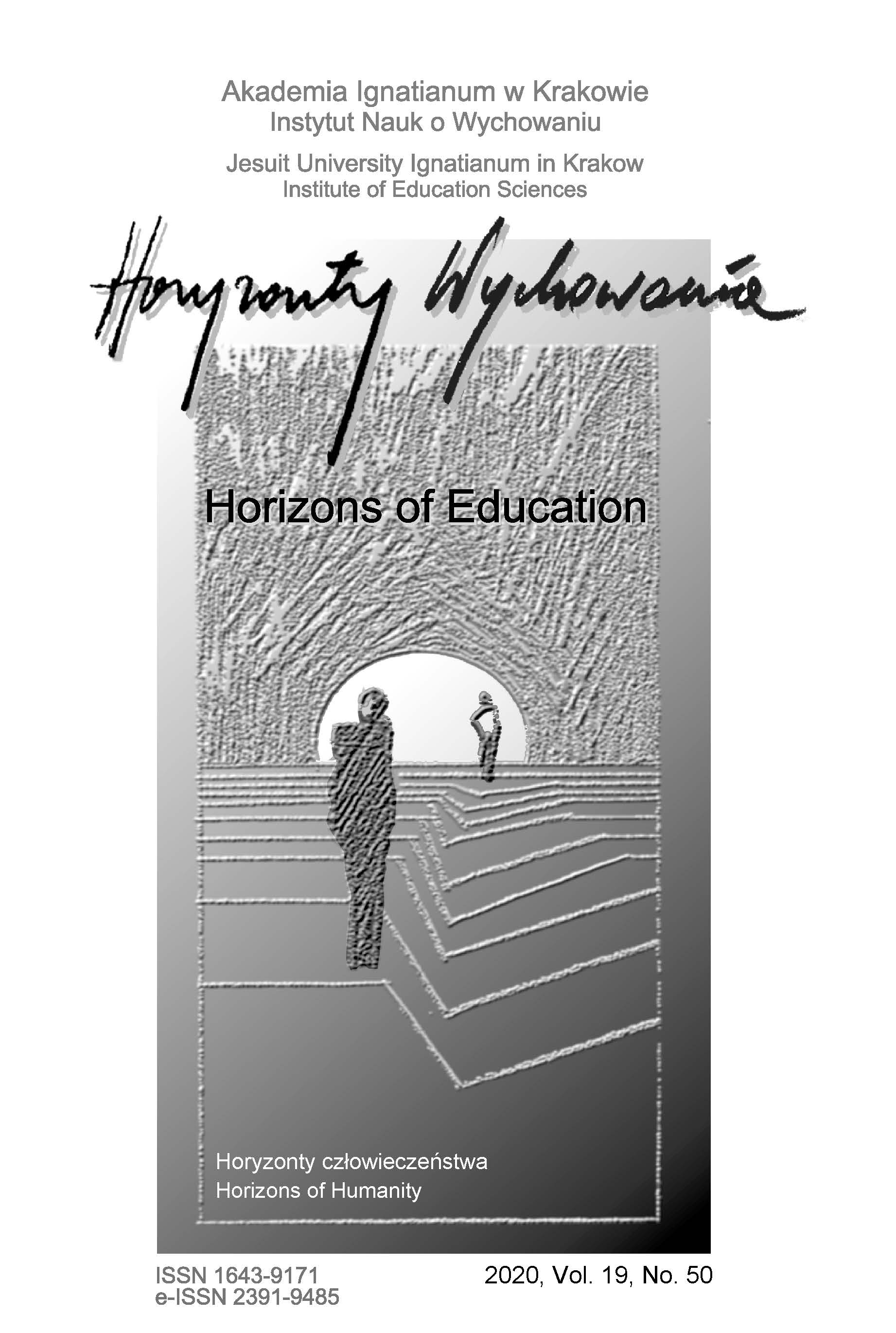Społeczna percepcja dystansu i tolerancji
Abstract
RESEARCH OBJECTIVE: The article aims to present the relationship between the notions of distance and tolerance.
THE RESEARCH PROBLEM AND METHODS: The main concern of the article is to classify the features that characterize the attitudes of tolerance and distance, and to determine their inner structures. Research method: diagnostical survey including the original tolerance and distance scale (STD) and the questionnaire.
THE PROCESS OF ARGUMENTATION: The notions of distance and tolerance were compared and contrasted based on the number of various definitions. Afterwards, the method of measuring those two attitudes was presented. Then, the research findings and the relationship between distance and tolerance were described. The concluding part highlighted the essence of those attitudes and the need for further research on them, as well as their role in the pedagogy studies.
RESEARCH RESULTS: The conducted analyses led to creating the ranking of the features of tolerance and distance of the examined individuals. The rank data was then transformed into the standardized results and the factor analysis using the principal components method was performed, isolating the factors of distance and tolerance. Cluster analysis using the k-means method determined the distance profiles of the examined people, and then the relationships between the types of declared distance and tolerance attitudes were specified with the help of the multi-step regression method.
CONCLUSIONS, INNOVATIONS AND RECOMMENDATIONS: The research findings indicate the specific configurations of the notions characterizing the attitudes of tolerance and distance. Both of them may be observed in the positive and negative situational context, where their social perception is usually simplified, one-dimensional and stereotypical, but they translate into social awareness into human functioning in everyday life, including the relationships between them. Regarding the need for education of children in the atmosphere of tolerance, the research on this phenomenon should be further developed.
References
Ambrosewicz-Jacobs, J. (2004). Tolerancja jak uczyć siebie i innych, Kraków, Wyd. Villa Decjusza.
Arnold, A. (2011) Słownik języka polskiego, Bielsko-Biała, Wydawnictwo Szkolne PWN.
Bazaniak, J. (2009). Inność obiektem tolerancji. Kształtowanie postaw tolerancyjnych u dzieci w wieku wczesnoszkolnym w ich środowisku edukacyjnym, w: Poznańskie Studia Teologiczne, T. 23, s. 323-357.
Chapman, C.B. and Cooper, D.F. (1983). Risk Analysis: Testing Some Prejudices. European Journal of Operational Research, 14, s. 238-247.
Chodkowska, M. (2012). Socjopedagogiczne wymiary dystansu społecznego, w: Dystans społeczny w teorii i praktyce pedagogicznej, M. Chodkowska, S. Byra (red), Lublin: Wydawnictwo Uniwersytetu Marii Curie Skłodowskiej, s. 15-34.
Cohen, A.J. (2014). Toleration, Published by John Wiley & Sons (UK)
Gajdzica, Z. (2012). Dystans społeczny wobec osób z upośledzeniem umysłowym jako czynnik determinujący ich marginalizację, w: Chowanna, t.1 (38), Katowice, Wydawnictwo Uniwersytetu Śląskiego, s. 83-92.
Kirenko, J. i Korczyński, M. (2008). Wobec niepełnosprawności, Lublin: Wydawnictwo Akademickie Wyższej Szkoły Społeczno-Przyrodniczej im. W. Pola.
Kirenko, J. i Olejnik, U., (2012). Dystans versus tolerancja- próba pomiaru,
w: Dystans społeczny w teorii i praktyce pedagogicznej, M. Chodkowska,
S. Byra (red), Lublin: Wydawnictwo UMCS, s. 47-56.
Kołakowski, L. (2000). Miniwykład o maxi-sprawach, Kraków, Wydawnictwo Znak.
Kopińska, V. (2008). Między akceptacją a wrogością. Tolerancja w ujęciu uczniów toruńskich szkół średnich, w: Tolerancja a edukacja, M. Palaton (red.) , Gdańsk: Wyd. Uniwersytetu Gdańskiego, s. 535-544.
Krzysztofek, K. (2010). Tolerancja i nietolerancja: kilka pytań i hipotez badawczych, w: I. Jakubowska-Branicka (red.): O tolerancji we współczesnej demokracji liberalnej, Warszawa, Wydawnictwo Trio.
Legutko, R. (1993). Nie lubię tolerancji, Szkice i felietony, Wydawnictwo Arka, Kraków.
Liberman, N. i Trope, Y. i Stephan, E. (2007). Psychological distance, w: A. W. Kruglanski & E. T. Higgins (Eds.), Social psychology: Handbook of basic principles. New York, Guilford Press, s. 353-383.
Maryniarczyk, A. (red) (2008). Powszechna Encyklopedia Filozofii, Lublin, Polskie Towarzystwo Św. Tomasza z Akwinu.
McKinnon C., 2006, Tolerantion, A critical introducion, Routledge London
Olejnik, U. (2015). Psychospołeczne zasoby osób słabowidzących a ich postawy zdystansowania versus tolerancyjności, Niepublikowana rozprawa doktorska, Uniwersytet Marii Curie-Skłodowskiej w Lublinie.
Olejnik, U. (2018). Postawy zdystansowania i tolerancyjności młodzieży słabowidzącej, Lublin, Wydawnictwo UMCS.
Reber, A.S. i Reber E.S. (2005). Słownik psychologii, Warszawa:
Wyd. Naukowe „Scholar”.
Sak, J.J. (2002). Dystans i tolerancja, Annales Universitatis Mariae Curie-Skłodowska, Lublin: Polonia, Vol. XXVII, 11, s. 198-207.
Szczupał B. (2012). Dystans społeczny wobec osób ze zniekształceniami twarzy, w: Dystans społeczny wobec osób z niepełnosprawnością jako problem pedagogiki specjalnej. Tom I. Przyczyny – Konsekwencje – Przeciwdziałanie, M. Parchomiuk, B. Szabała (red.), Lublin: Wydawnictwo UMCS, s. 67-87.
Thomas, M. i Tsai C.I., (2012). Psychological distance and subjective experience : how distancing reduces the feeling of difficulty, Journal of Consumer Research, vol. 39, issue 2 s. 324-340.
Wiśniewski J.W. (2014). Dylematy stosowania współczynnika korelacji Spearmana , Studia Ekonomiczne, nr 181, s. 174-184.
Wójcik, M. (2018) XVII Ogólnopolska Konferencja Nauczycieli i Wychowawców Nauczyciel i szkoła w trosce o dobro dziecka. W: Roczniki Pedagogiczne, t.10 (46), n.4, Towarzystwo Naukowe KUL & Katolicki Uniwersytet Lubelski Jana Pawła II s.127-129.
Copyright (c) 2020 Janusz Kirenko, Urszula Olejnik

This work is licensed under a Creative Commons Attribution-NoDerivatives 4.0 International License.
Authors who publish in this journal agree to the following terms:
- Authors retain the copyright to their work while granting the journal the right of first publication. The work will be simultaneously licensed under a CC BY-ND license, which permits others to share the work with proper credit given to the author and the original publication in this journal.
- Authors may enter into additional, non-exclusive agreements for the distribution of the published version of the work (e.g., posting it in an institutional repository or publishing it in another journal), provided that the original publication in this journal is acknowledged.
We allow and encourage authors to share their work online (e.g., in institutional repositories or on personal websites) both before and during the submission process, as this can foster beneficial exchanges and lead to earlier and increased citations of the published work. (See The Effect of Open Access). We recommend using any of the following academic networking platforms:





